Modes of Occurrence and Origin of Minerals in Permian Coals from the Huainan Coalfield, Anhui, China
Abstract
:1. Introduction
2. Geological Setting
3. Materials and Methods
4. Results
4.1. Coal Quality Parameters
4.2. Major Elements in the Coal
4.3. Mineral Compositions in the Coal
4.4. Modes of Mineral Occurrence
4.4.1. Quartz
4.4.2. Clay Minerals
4.4.3. Carbonate Minerals
4.4.4. Pyrite
4.4.5. Other Minerals
5. Discussion
5.1. Origin of Minerals in the Coal Samples
5.1.1. Detrital Input
5.1.2. Syngenetic and Early Diagenetic Precipitation
5.1.3. Epigenetic Precipitation
5.2. Implication for Geological Evolution
6. Conclusions
Author Contributions
Funding
Acknowledgments
Conflicts of Interest
References
- Finkelman, R.B.; Dai, S.F.; French, D. The importance of minerals in coal as the hosts of chemical elements: A review. Int. J. Coal Geol. 2019, 212, 103251. [Google Scholar] [CrossRef]
- Dai, S.F.; Finkelman, R.B. Coal geology in China: An overview. Int. Geol. Rev. 2018, 60, 531–534. [Google Scholar] [CrossRef] [Green Version]
- Dai, S.F.; Chou, C.L. Occurrence and origin of minerals in a chamosite-bearing coal of Late Permian age, Zhaotong, Yunnan, China. Am. Mineral. 2007, 92, 1253–1261. [Google Scholar] [CrossRef]
- Wang, X.B.; Dai, S.F.; Ren, D.Y.; Yang, J.Y. Mineralogy and geochemistry of Al-hydroxide/oxyhydroxide mineral-bearing coals of Late Paleozoic age from the Weibei coalfield, southeastern Ordos Basin, North China. Appl. Geochem. 2011, 26, 1086–1096. [Google Scholar] [CrossRef]
- Ward, C.R. Analysis and significance of mineral matter in coal seams. Int. J. Coal Geol. 2002, 50, 135–168. [Google Scholar] [CrossRef]
- Ward, C.R. Analysis, origin and significance of mineral matter in coal: An updated review. Int. J. Coal Geol. 2016, 165, 1–27. [Google Scholar] [CrossRef]
- Dai, S.F.; Ji, D.P.; Ward, C.R.; French, D.; Hower, J.C.; Yan, X.Y.; Wei, Q. Mississippian anthracites in Guangxi Province, southern China: Petrological, mineralogical, and rare earth element evidence for high-temperature solutions. Int. J. Coal Geol. 2018, 197, 84–114. [Google Scholar] [CrossRef]
- Dai, S.F.; Bechtel, A.; Eble, C.F.; Flores, R.M.; French, D.; Graham, I.T.; Hood, M.M.; Hower, J.C.; Korasidis, V.A.; Moore, T.A.; et al. Recognition of peat depositional environments in coal: A review. Int. J. Coal Geol. 2020, 219, 103383. [Google Scholar] [CrossRef]
- Dai, S.F.; Zou, J.H.; Jiang, Y.F.; Ward, C.R.; Wang, X.B.; Li, T.; Xue, W.F.; Liu, S.D.; Tian, H.M.; Sun, X.H.; et al. Mineralogical and geochemical compositions of the Pennsylvanian coal in the Adaohai Mine, Daqingshan Coalfield, Inner Mongolia, China: Modes of occurrence and origin of diaspore, gorceixite, and ammonian illite. Int. J. Coal Geol. 2012, 94, 250–270. [Google Scholar] [CrossRef]
- Liu, X.B. The mineral matter characteristics of some Chinese coals. J. China Univ. Min. Technol. 1994, 23, 109–114. (In Chinese) [Google Scholar] [CrossRef]
- Kong, H.L.; Zeng, R.S.; Zhuang, X.G. Research on the Minerals in Coals. Acta Petrol. Mineral. 2001, 20, 441–444. (In Chinese) [Google Scholar] [CrossRef]
- Spiro, B.F.; Liu, J.J.; Dai, S.F.; Zeng, R.S.; Large, D.; French, D. Marine derived 87Sr/86Sr in coal, a new key to geochronology and palaeoenvironment: Elucidation of the India-Eurasia and China-Indochina collisions in Yunnan, China. Int. J. Coal Geol. 2019, 215. [Google Scholar] [CrossRef]
- Yao, Y.B.; Liu, D.M.; Huang, W.H. Influences of igneous intrusions on coal rank, coal quality and adsorption capacity in Hongyang, Handan and Huaibei coalfields, North China. Int. J. Coal Geol. 2011, 88, 135–146. [Google Scholar] [CrossRef]
- Singh, A.K.; Sharma, M.; Singh, M.P. Genesis of natural cokes: Some Indian examples. Int. J. Coal Geol. 2008, 75, 40–48. [Google Scholar] [CrossRef]
- Juster, T.C.; Brown, P.E.; Bailey, S.W. NH4-bearing illite in very low grade metamorphic rocks associated with coal, northeastern Pennsylvania. Am. Mineral. 1987, 72, 555–565. [Google Scholar]
- Dai, S.F.; Wang, X.B.; Seredin, V.V.; Hower, J.C.; Ward, C.R.; O’Keefe, J.M.K.; Huang, W.H.; Li, T.; Li, X.; Liu, H.D.; et al. Petrology, mineralogy, and geochemistry of the Ge-rich coal from the Wulantuga Ge ore deposit, Inner Mongolia, China: New data and genetic implications. Int. J. Coal Geol. 2012, 90–91, 72–99. [Google Scholar] [CrossRef]
- Yang, M.; Liu, G.J.; Sun, R.Y.; Chou, C.L.; Zheng, L.G. Characterization of intrusive rocks and REE geochemistry of coals from the Zhuji Coal Mine, Huainan Coalfield, Anhui, China. Int. J. Coal Geol. 2012, 94, 283–295. [Google Scholar] [CrossRef]
- Wu, D. Research on Nano-Structure of Magmatic Contact Metamorphosed Coal (P1) at Huainan Coalfield; University of Science and Technology of China: Hefei, China, 2014. (In Chinese) [Google Scholar]
- Huang, H.; Han, B.W.; Cheng, S.D. Characteristics of REEs in coals from the igneous intrusion area of the Zhuji Coal Mine, Anhui. Bull. Mineral. Petrol. Geochem. 2014, 33, 493–499. (In Chinese) [Google Scholar] [CrossRef]
- Miao, L.; Liu, G.J.; Wu, D.; Wu, B.; Chen, J. Magmatic intrusive age determination and its significance in Western Zhuji No.3 Minefield, Huainan Coalfield. Coal Geol. China 2012, 24, 1–6. (In Chinese) [Google Scholar] [CrossRef]
- Liu, D.M.; Yao, Y.B.; Tang, D.Z.; Tang, S.H.; Che, Y.; Huang, W.H. Coal reservoir characteristics and coalbed methane resource assessment in Huainan and Huaibei coalfields, Southern North China. Int. J. Coal Geol. 2009, 79, 97–112. [Google Scholar] [CrossRef]
- Chen, J.; Liu, G.J.; Li, H.; Wu, B. Mineralogical and geochemical responses of coal to igneous intrusion in the Pansan Coal Mine of the Huainan coalfield, Anhui, China. Int. J. Coal Geol. 2014, 124, 11–35. [Google Scholar] [CrossRef]
- Wei, Q.; Li, X.Q.; Hu, B.L.; Zhang, X.Q.; Zhang, J.Z.; He, Y.K.; Zhang, Y.C.; Zhu, W.W. Reservoir characteristics and coalbed methane resource evaluation of deep-buried coals: A case study of the No.13–1 coal seam from the Panji Deep Area in Huainan Coalfield, Southern North China. J. Pet. Sci. Eng. 2019, 179, 867–884. [Google Scholar] [CrossRef]
- Li, Z.X.; Wei, J.C.; Jin, X.K. High-resolution sequence stratigraphic characterstics in the Permian from Huainan coalfield. J. Stratigr. 2000, 24, 34–39. (In Chinese) [Google Scholar] [CrossRef]
- Hu, B.L.; Gao, D.Y.; Liu, H.H.; Xu, H.J.; Zhang, P.; Sun, F. Relationship between sedimentary facies and source rocks of Permian strata in Huainan coalfield. Coal Geol. Explor. 2017, 45, 1–6. [Google Scholar] [CrossRef]
- Lan, C.Y.; Yang, B.C.; Peng, S.P. Environment for forming major coal seam of Permian coal-bearing series in Huainan coalfield. J. China Coal Soc. 1988, 11–22. (In Chinese) [Google Scholar] [CrossRef]
- Sun, R.Y.; Liu, G.J.; Zheng, L.G.; Chou, C.L. Characteristics of coal quality and their relationship with coal-forming environment: A case study from the Zhuji exploration area, Huainan coalfield, Anhui, China. Energy 2010, 35, 423–435. [Google Scholar] [CrossRef]
- Chen, J.; Liu, G.J.; Jiang, M.M.; Chou, C.L.; Li, H.; Wu, B.; Zheng, L.G.; Jiang, D.D. Geochemistry of environmentally sensitive trace elements in Permian coals from the Huainan coalfield, Anhui, China. Int. J. Coal Geol. 2011, 88, 41–54. [Google Scholar] [CrossRef]
- Zhao, Z.G.; Tang, X.Y.; Li, B.F. Geochemistry of rare-earth elements of coal in Huainan mining area. Acta Sedimentol. Sin. 2000, 18, 453–459. (In Chinese) [Google Scholar] [CrossRef]
- Liu, B.X.; Liu, C.P.; Sun, M.C.; Liu, G.J. A study on magmatic intrusion features in Zhuji minefield, Huainan coalfield. Coal Geol. China 2010, 22, 13–16. (In Chinese) [Google Scholar] [CrossRef]
- Zhang, W.Y.; Zhu, W.W.; Dou, X.Z.; Zhao, Z.Y.; Hu, G.Q.; Ding, H.; Yi, X.H. Research progress on coal measure natural gas exploration development in Huaibei and Huainan coalfields. Coal Sci. Technol. 2018, 46, 245–251. (In Chinese) [Google Scholar] [CrossRef]
- ASTM D3173/D3173M-17. Standard Test Method for Moisture in the Analysis Sample of Coal and Coke; ASTM International: West Conshohocken, PA, USA, 2017. [Google Scholar]
- ASTM D3175-18. Standard Test Method for Volatile Matter in the Analysis Sample of Coal and Coke; ASTM International: West Conshohocken, PA, USA, 2018. [Google Scholar]
- ASTM D3174-12. Standard Test Method for Ash in the Analysis Sample of Coal and Coke from Coal; ASTM International: West Conshohocken, PA, USA, 2018. [Google Scholar]
- ASTM D4239-18e1. Standard Test Method for Sulfur in the Analysis Sample of Coal and Coke Using High-Temperature Tube Furnace Combustion; ASTM International: West Conshohocken, PA, USA, 2018. [Google Scholar]
- Chung, F.H. Quantitative interpretation of X-ray diffraction patterns of mixtures. II. Adiabatic principle of X-ray diffraction analysis of mixtures. J. Appl. Crystallogr. 1974, 7, 526–531. [Google Scholar] [CrossRef]
- Ao, W.H. The Characteristics of Deep-Seated Coal Seams’ Rank/Coal’s Structure and Coalification in Huainan Coalfield; China University of Geosciences (Beijing): Beijing, China, 2013. (In Chinese) [Google Scholar]
- Jiang, D.D.; Chen, P.; Tang, X.Y.; Hong, A.N. Characteristic study and geological genesis analysis of pyrite in No.8 coal in Huainan Coalfield. Coal Geol. China 2009, 21, 22–26. (In Chinese) [Google Scholar]
- GB/T 15224.1-2018. Classification for Quality of Coal, Part 1: Ash Yield; Chinese National Standard; General Administration of Quality Supervision, Inspection and Quarantine of the People’s Republic of China: Beijing, China, 2018. (In Chinese) [Google Scholar]
- ASTM D388-15. Standard Classification of Coals by Rank; ASTM International: West Conshohocken, PA, USA, 2015. [Google Scholar]
- GB/T 15224.2-2010. Classification for Quality of Coal, Part 2: Sulfur Content; Chinese National Standard; General Administration of Quality Supervision, Inspection and Quarantine of the People’s Republic of China: Beijing, China, 2010. (In Chinese) [Google Scholar]
- Ward, C.R.; Christie, P.J. Clays and other minerals in coal seams of the Moura-Baralaba area, Bowen Basin, Australia. Int. J. Coal Geol. 1994, 25, 287–309. [Google Scholar] [CrossRef]
- Mraw, S.C.; De Neufville, J.P.; Freund, H.; Baset, Z.; Gorbaty, M.L.; Wright, F.J. Science of mineral matter in coal. In Coal Science; Gorbaty, M., Larsen, J., Wender, I., Eds.; Academic Press: New York, NY, USA, 1983; Volume 2, pp. 1–63. ISBN 0121507025. [Google Scholar]
- Dai, S.F.; Zhang, W.G.; Ward, C.R.; Seredin, V.V.; Hower, J.C.; Li, X.; Song, W.J.; Wang, X.B.; Kang, H.; Zheng, L.C.; et al. Mineralogical and geochemical anomalies of late Permian coals from the Fusui Coalfield, Guangxi Province, southern China: Influences of terrigenous materials and hydrothermal fluids. Int. J. Coal Geol. 2013, 105, 60–84. [Google Scholar] [CrossRef]
- Ward, C.R. Minerals in bituminous coals of the Sydney basin (Australia) and the Illinois basin (U.S.A.). Int. J. Coal Geol. 1989, 13, 455–479. [Google Scholar] [CrossRef]
- Li, B.Q.; Zhuang, X.G.; Querol, X.; Moreno, N.; Córdoba, P.; Li, J.; Zhou, J.B.; Ma, X.P.; Liu, S.B.; Shangguan, Y.F. The mode of occurrence and origin of minerals in the Early Permian high-rank coals of the Jimunai depression, Xinjiang Uygur Autonomous Region, NW China. Int. J. Coal Geol. 2019, 205, 58–74. [Google Scholar] [CrossRef]
- Dai, S.F.; Ren, D.Y.; Chou, C.L.; Li, S.S.; Jiang, Y.F. Mineralogy and geochemistry of the No. 6 Coal (Pennsylvanian) in the Junger Coalfield, Ordos Basin, China. Int. J. Coal Geol. 2006, 66, 253–270. [Google Scholar] [CrossRef]
- Dai, S.F.; Hower, J.C.; Ward, C.R.; Guo, W.M.; Song, H.J.; O’Keefe, J.M.K.; Xie, P.P.; Hood, M.M.; Yan, X.Y. Elements and phosphorus minerals in the middle Jurassic inertinite-rich coals of the Muli Coalfield on the Tibetan Plateau. Int. J. Coal Geol. 2015, 144–145, 23–47. [Google Scholar] [CrossRef]
- Love, L.G. Mircro-organisms and the presence of syngenetic pyrite. Q. J. Geol. Soc. Lond. 1957, 113, 429–440. [Google Scholar] [CrossRef]
- Wilkin, R.T.; Barnes, H.L. Formation processes of framboidal pyrite. Geochim. Cosmochim. Acta 1997, 61, 323–339. [Google Scholar] [CrossRef]
- Sweeney, R.E.; Kaplan, I.R. Pyrite framboid formation; Laboratory synthesis and marine sediments. Econ. Geol. 1973, 68, 618–634. [Google Scholar] [CrossRef]
- Kostova, I.; Petrov, O.; Kortenski, J. Mineralogy, geochemistry and pyrite content of Bulgarian subbituminous coals, Pernik Basin. Geol. Soc. Spec. Publ. 1996, 109, 301–314. [Google Scholar] [CrossRef]
- Fu, B.; Liu, G.J.; Liu, Y.; Cheng, S.W.; Qi, C.C.; Sun, R.Y. Coal quality characterization and its relationship with geological process of the Early Permian Huainan coal deposits, southern North China. J. Geochem. Explor. 2016, 166, 33–44. [Google Scholar] [CrossRef]
- Lan, C.Y. The sedimentary environment of the coal-bearing formation of the Permian period in the Huainan coalfield. J. Anhui Univ. Sci. Technol. 1984, 2, 10–22. (In Chinese) [Google Scholar]
- Lan, C.Y. Sedimentary characteristics and environments of Carboniferous Permian coal-bearing rock measures in Huainan-Huaibei coalfields. J. Anhui Univ. Sci. Technol. 1989, 3, 9–22. (In Chinese) [Google Scholar]
- Butler, I.B.; Rickard, D. Framboidal pyrite formation via the oxidation of iron (II) monosulfide by hydrogen sulphide. Geochim. Cosmochim. Acta 2000, 64, 2665–2672. [Google Scholar] [CrossRef]
- Rickard, D. Kinetics of pyrite formation by the H2S oxidation of iron (II) monosulfide in aqueous solutions between 25 and 125 °C: The rate equation. Geochim. Cosmochim. Acta 1997, 61, 115–134. [Google Scholar] [CrossRef]
- Permana, A.K.; Ward, C.R.; Li, Z.; Gurba, L.W. Distribution and origin of minerals in high-rank coals of the South Walker Creek area, Bowen Basin, Australia. Int. J. Coal Geol. 2013, 116–117, 185–207. [Google Scholar] [CrossRef]
- Dai, S.F.; Tian, L.W.; Chou, C.L.; Zhou, Y.P.; Zhang, M.Q.; Zhao, L.; Wang, J.M.; Yang, Z.; Cao, H.Z.; Ren, D.Y. Mineralogical and compositional characteristics of Late Permian coals from an area of high lung cancer rate in Xuan Wei, Yunnan, China: Occurrence and origin of quartz and chamosite. Int. J. Coal Geol. 2008, 76, 318–327. [Google Scholar] [CrossRef]
- Dai, S.F.; Jiang, Y.F.; Ward, C.R.; Gu, L.D.; Seredin, V.V.; Liu, H.D.; Zhou, D.; Wang, X.B.; Sun, Y.Z.; Zou, J.H.; et al. Mineralogical and geochemical compositions of the coal in the Guanbanwusu Mine, Inner Mongolia, China: Further evidence for the existence of an Al (Ga and REE) ore deposit in the Jungar Coalfield. Int. J. Coal Geol. 2012, 98, 10–40. [Google Scholar] [CrossRef]
- Dong, Y.; Lan, C.Y.; Zeng, Q.P.; Yang, B.C. Lithofacies and paleogeography from Late Carboniferous to early stage of Late Permian in Huainan-Huaibei coalfields. Coal Geol. Explor. 1994, 22, 9–12. (In Chinese) [Google Scholar]
- Diessel, C.; Boyd, R.; Wadsworth, J.; Leckie, D.; Chalmers, G. On balanced and unbalanced accommodation/peat accumulation ratios in the Cretaceous coals from Gates Formation, Western Canada, and their sequence-stratigraphic significance. Int. J. Coal Geol. 2000, 43, 143–186. [Google Scholar] [CrossRef]
- Rimmer, S.M.; Yoksoulian, L.E.; Hower, J.C. Anatomy of an intruded coal, I: Effect of contact metamorphism on whole-coal geochemistry, Springfield (No. 5) (Pennsylvanian) coal, Illinois Basin. Int. J. Coal Geol. 2009, 79, 74–82. [Google Scholar] [CrossRef]
- Querol, X.; Chinchon, S.; Lopez-Soler, A. Iron sulfide precipitation sequence in Albian coals from the Maestrazgo Basin, southeastern Iberian Range, northeastern Spain. Int. J. Coal Geol. 1989, 11, 171–189. [Google Scholar] [CrossRef]
- Chou, C.L. Sulfur in coals: A review of geochemistry and origins. Int. J. Coal Geol. 2012, 100, 1–13. [Google Scholar] [CrossRef]
- Ward, C.R. Mineral matter in low-rank coals and associated strata of the Mae Moh basin, northern Thailand. Int. J. Coal Geol. 1991, 17, 69–93. [Google Scholar] [CrossRef]
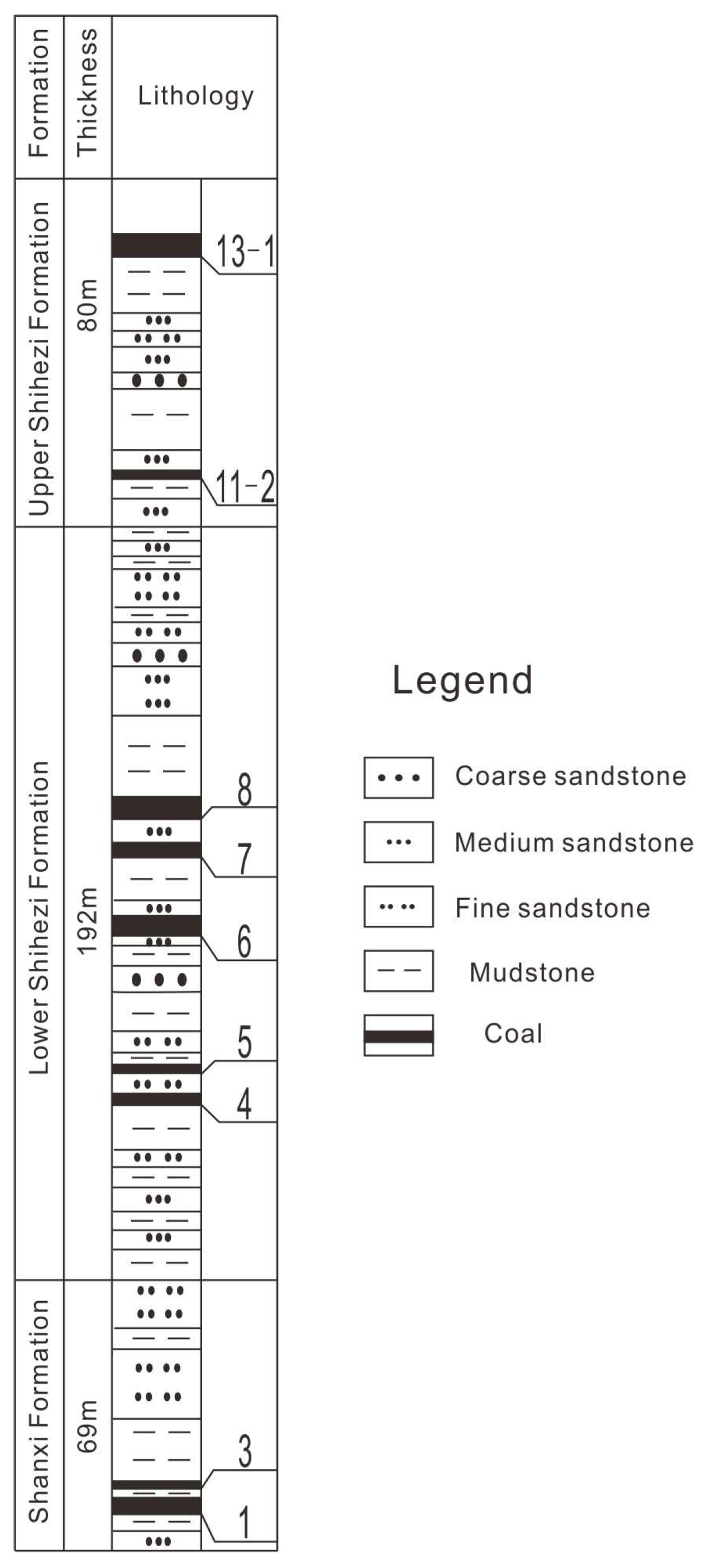


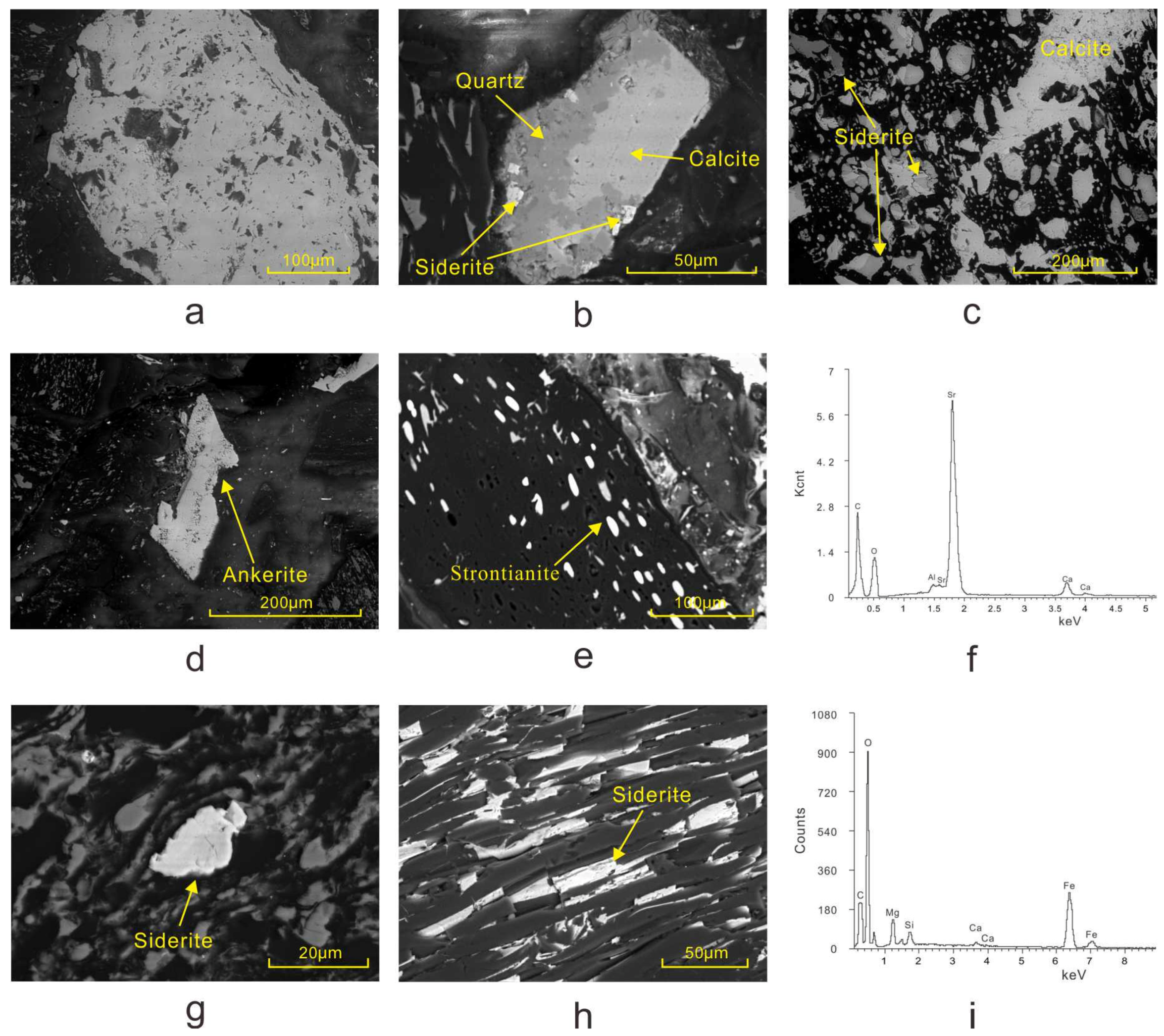
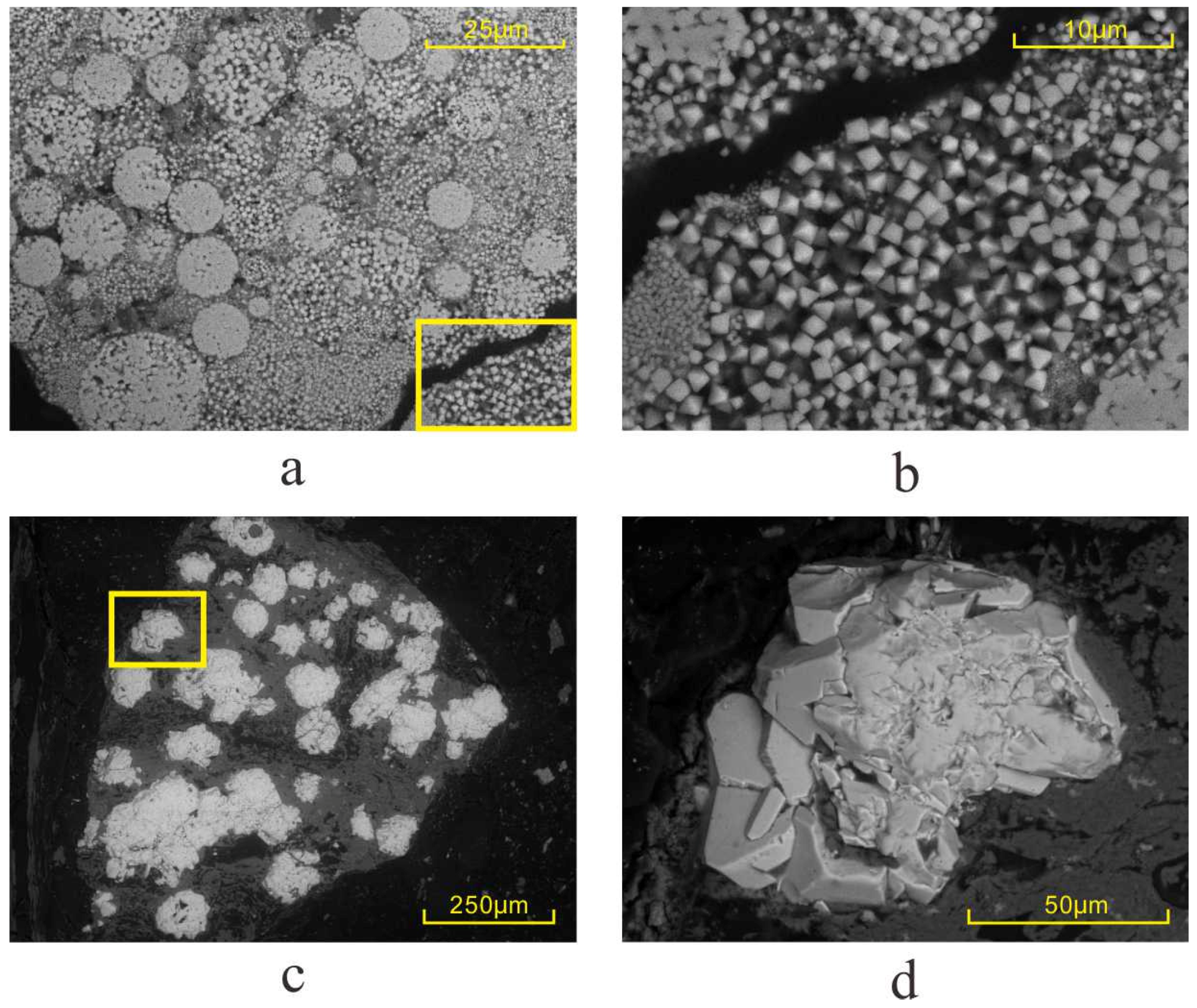
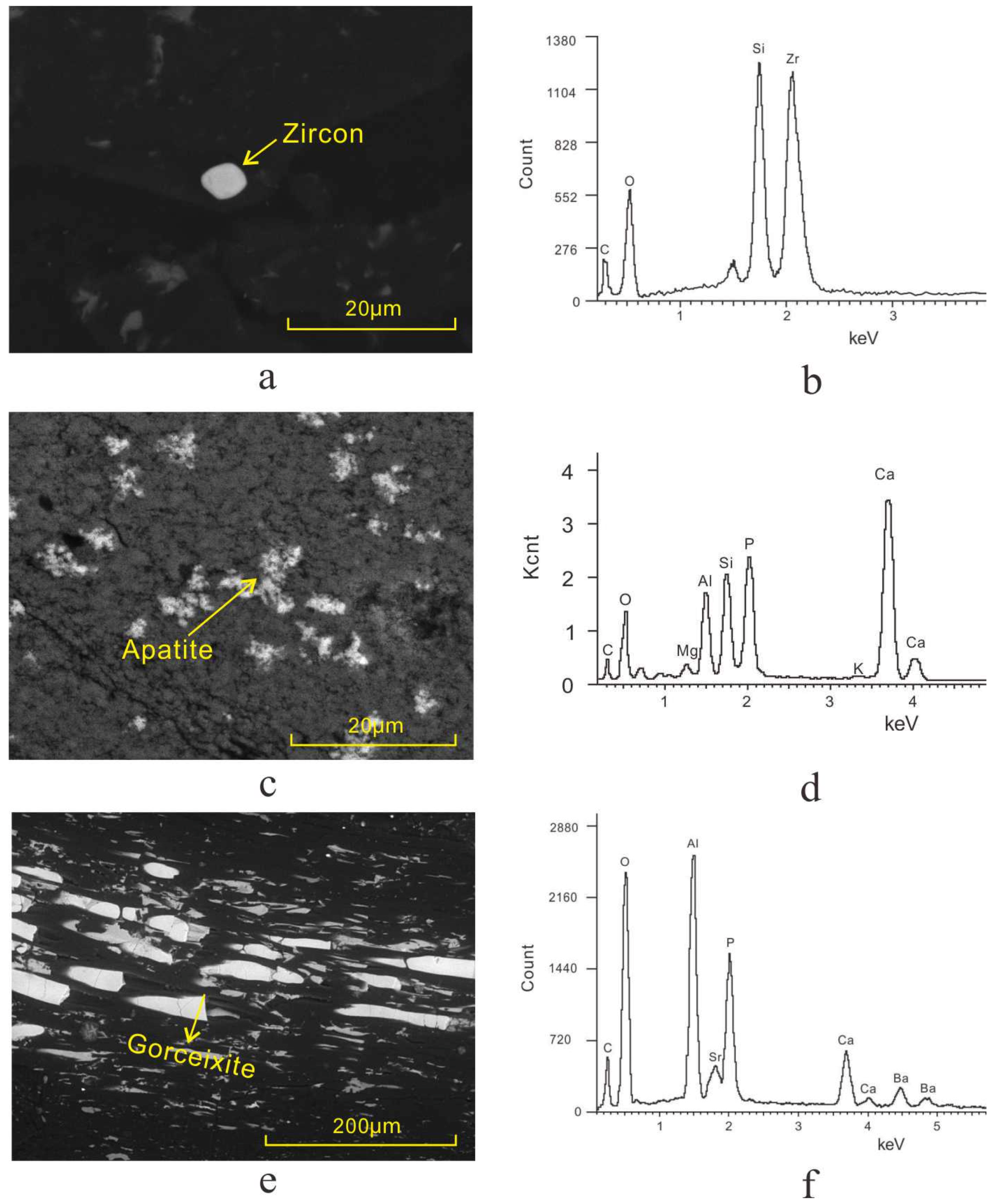
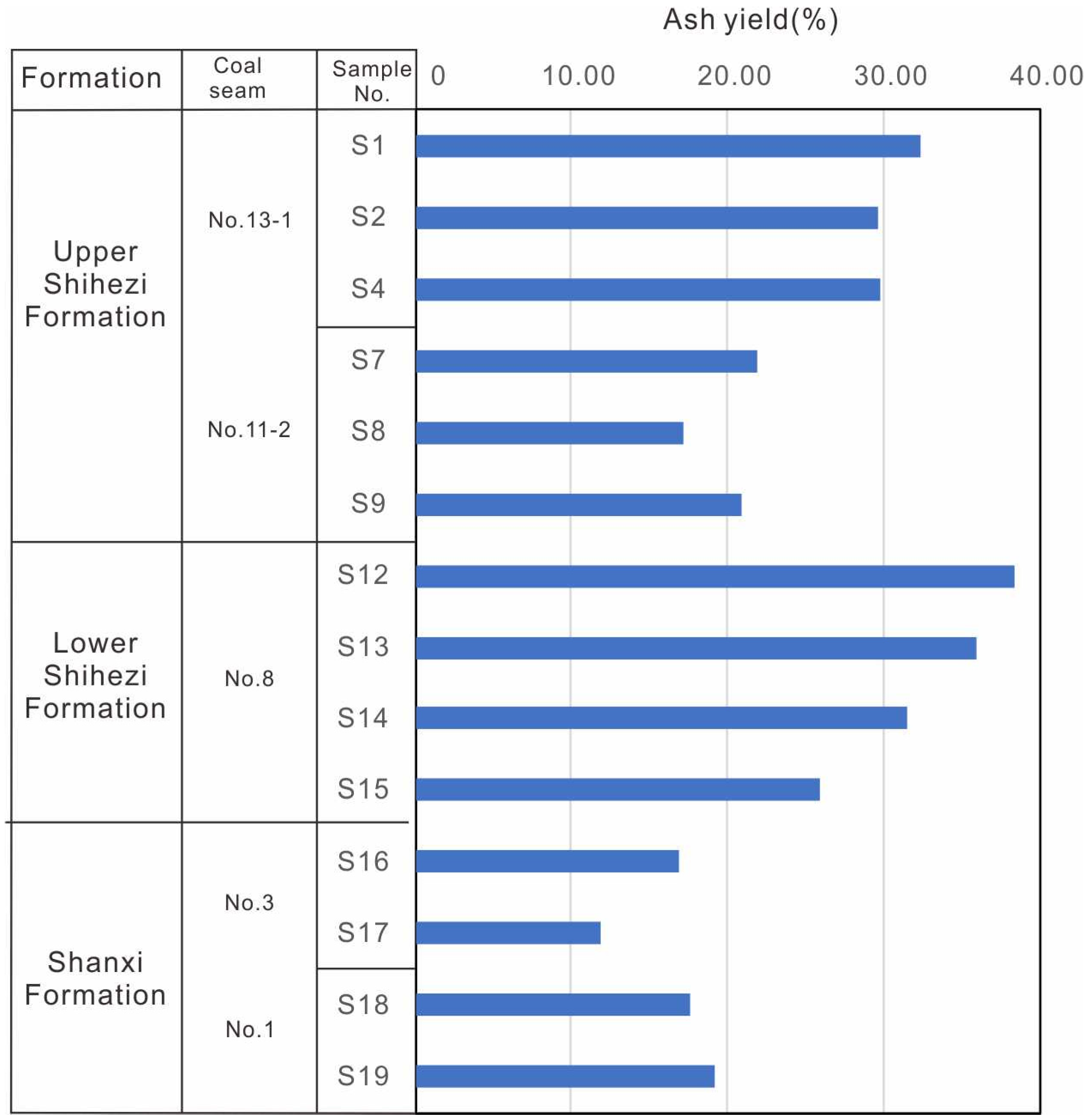

| Coal Mine | Borehole | Coal Seam No. | Sample No. | Mad | Ad | Vdaf | St,d |
|---|---|---|---|---|---|---|---|
| P1 | B1-9 | 13-1 | S1 | 1.30 | 32.39 | 41.33 | 0.20 |
| P1 | B1-1 | 13-1 | S2 | 1.48 | 29.60 | 43.41 | 0.13 |
| P1 | B2-3 | 13-1 | S4 | 0.72 | 29.76 | 36.29 | 0.13 |
| WFG * | - | 13-1 | - | 0.75 | 23.05 | 25.13 | nd |
| P1 | B1-9 | 11-2 | S7 | 1.02 | 21.96 | 38.02 | 0.21 |
| P1 | B1-2 | 11-2 | S8 | 1.02 | 17.23 | 37.53 | 0.26 |
| P1 | B2-3 | 11-2 | S9 | 0.66 | 20.83 | 34.17 | 0.41 |
| P1 | B1-9 | 8 | S12 | 1.08 | 38.31 | 37.34 | 0.31 |
| P1 | B1-1 | 8 | S13 | 1.06 | 35.89 | 41.40 | 0.43 |
| P1 | B1-2 | 8 | S14 | 1.14 | 31.47 | 38.88 | 0.29 |
| P1 | B2-3 | 8 | S15 | 0.78 | 25.91 | 35.02 | 0.69 |
| GQ ** | - | 8 | - | nd | nd | nd | 1.20 |
| XZZ ** | - | 8 | - | nd | nd | nd | 0.69 |
| P1 | B1-9 | 3 | S16 | 1.02 | 16.86 | 36.23 | 0.42 |
| P1 | B1-2 | 3 | S17 | 0.89 | 11.92 | 36.66 | 0.51 |
| P1 | B1-9 | 1 | S18 | 0.96 | 17.56 | 36.25 | 0.63 |
| P1 | B1-2 | 1 | S19 | 1.10 | 19.21 | 35.66 | 1.51 |
| Coal Mine | Borehole | Coal Seam No. | Sample No. | SiO2 | TiO2 | Al2O3 | Fe2O3 | MgO | CaO | Na2O | K2O | SO3 |
|---|---|---|---|---|---|---|---|---|---|---|---|---|
| P1 | B1-9 | 13-1 | S1 | 53.90 | 1.21 | 33.51 | 3.73 | 1.11 | 3.94 | 0.66 | 1.01 | 0.93 |
| P1 | B1-1 | 13-1 | S2 | 56.87 | 0.73 | 29.57 | 4.95 | 1.30 | 5.16 | 0.29 | 0.42 | 0.70 |
| P1 | B2-3 | 13-1 | S4 | 56.47 | 1.26 | 30.58 | 4.03 | 1.10 | 4.17 | 0.46 | 1.07 | 0.87 |
| P1 | B1-9 | 11-2 | S7 | 56.39 | 0.97 | 31.84 | 4.28 | 1.21 | 2.72 | 0.66 | 1.31 | 0.64 |
| P1 | B1-2 | 11-2 | S8 | 52.83 | 1.23 | 34.38 | 5.33 | 1.06 | 2.50 | 0.41 | 1.42 | 0.83 |
| P1 | B2-3 | 11-2 | S9 | 57.68 | 1.28 | 31.76 | 4.81 | 0.46 | 1.11 | 0.46 | 1.44 | 1.00 |
| GQ | B3-1 | 8 | S10 | 53.69 | 0.96 | 32.51 | 5.53 | 1.05 | 2.63 | 0.41 | 0.61 | 2.62 |
| XZZ | B3-2 | 8 | S11 | 57.38 | 1.16 | 30.84 | 5.37 | 0.56 | 1.24 | 0.68 | 1.14 | 1.65 |
| P1 | B1-9 | 8 | S12 | 60.32 | 1.05 | 27.69 | 4.58 | 1.03 | 2.51 | 0.48 | 1.11 | 1.23 |
| P1 | B1-1 | 8 | S13 | 56.54 | 1.25 | 31.72 | 4.47 | 1.03 | 2.63 | 0.41 | 0.71 | 1.25 |
| P1 | B1-2 | 8 | S14 | 58.73 | 1.08 | 30.48 | 3.75 | 0.99 | 2.24 | 0.51 | 1.02 | 1.19 |
| P1 | B2-3 | 8 | S15 | 58.51 | 1.21 | 30.27 | 5.09 | 0.51 | 1.18 | 0.53 | 1.37 | 1.32 |
| P1 | B1-9 | 3 | S16 | 49.22 | 1.00 | 27.33 | 4.52 | 2.25 | 10.99 | 0.87 | 1.01 | 2.81 |
| P1 | B1-2 | 3 | S17 | 55.56 | 1.07 | 24.72 | 3.88 | 1.88 | 7.15 | 0.41 | 1.27 | 4.06 |
| P1 | B1-9 | 1 | S18 | 43.49 | 0.98 | 29.65 | 5.28 | 2.32 | 11.58 | 0.51 | 0.89 | 5.30 |
| P1 | B1-2 | 1 | S19 | 45.69 | 1.52 | 28.86 | 9.53 | 1.67 | 6.09 | 0.41 | 1.57 | 4.65 |
| Coal Mine | Borehole | Coal Seam No. | Sample No. | Clay | Quartz | Calcite | Pyrite |
|---|---|---|---|---|---|---|---|
| P1 | B1-1 | 13-1 | S2 | 84.9 | 5.2 | 9.9 | bdl |
| WFG | B3-3 | 13-1 | S6 | 82.6 | 5.6 | 11.2 | 0.7 |
| P1 | B2-3 | 11-2 | S9 | 88.9 | 10.9 | 0.2 | bdl |
| GQ * | - | 8 | - | 67.6 | 8.4 | 1.6 | 22.5 |
| XZZ * | - | 8 | - | 74.1 | 5.6 | 1.9 | 18.5 |
| P1 | B1-2 | 8 | S14 | 77.6 | 5.2 | 3.4 | 13.8 |
| P1 | B1-9 | 3 | S16 | 83.4 | 8.3 | 8.4 | bdl |
| P1 | B1-2 | 3 | S17 | 88.2 | 11.4 | 0.4 | bdl |
| P1 | B1-9 | 1 | S18 | 77.9 | 10.7 | 11.4 | bdl |
| P1 | B1-2 | 1 | S19 | 77.6 | 15.2 | 7.1 | bdl |
© 2020 by the authors. Licensee MDPI, Basel, Switzerland. This article is an open access article distributed under the terms and conditions of the Creative Commons Attribution (CC BY) license (http://creativecommons.org/licenses/by/4.0/).
Share and Cite
Li, Y.; Huang, W.; Jiu, B.; Sun, Q.; Che, Q. Modes of Occurrence and Origin of Minerals in Permian Coals from the Huainan Coalfield, Anhui, China. Minerals 2020, 10, 399. https://doi.org/10.3390/min10050399
Li Y, Huang W, Jiu B, Sun Q, Che Q. Modes of Occurrence and Origin of Minerals in Permian Coals from the Huainan Coalfield, Anhui, China. Minerals. 2020; 10(5):399. https://doi.org/10.3390/min10050399
Chicago/Turabian StyleLi, Yuan, Wenhui Huang, Bo Jiu, Qilong Sun, and Qingsong Che. 2020. "Modes of Occurrence and Origin of Minerals in Permian Coals from the Huainan Coalfield, Anhui, China" Minerals 10, no. 5: 399. https://doi.org/10.3390/min10050399
APA StyleLi, Y., Huang, W., Jiu, B., Sun, Q., & Che, Q. (2020). Modes of Occurrence and Origin of Minerals in Permian Coals from the Huainan Coalfield, Anhui, China. Minerals, 10(5), 399. https://doi.org/10.3390/min10050399






